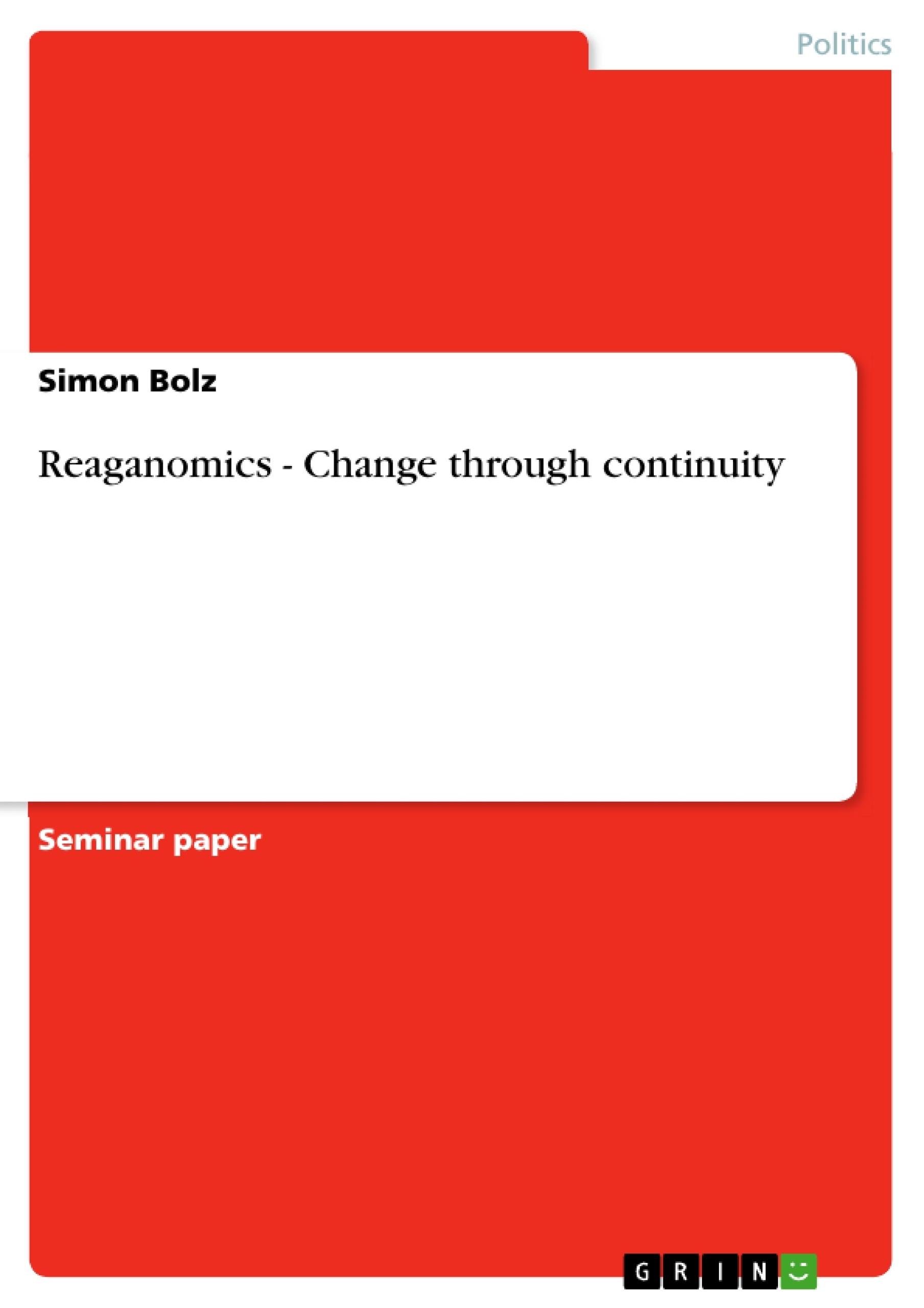This paper will focus on domestic policies introduced and tried to be introduced by the Reagan administration between 1980 and 1988, their success, and their consequences. The focus will be on taxation policies and retrenchment policies in government spending, particularly looking at the welfare state. First, the historical background and economic legacy of the 1960s and 1970s will be outlined in order to then analyze policies in the 1980s. A systematic three-step analysis will examine the goals, the actual measures, and the effects of policies within the fields of analysis. A concluding assessment will hopefully contribute to a clearer understanding of this important political era.
Inhaltsverzeichnis (Table of Contents)
- Reganomics: Change through Continuity
- Before 1980
- Promised change
Zielsetzung und Themenschwerpunkte (Objectives and Key Themes)
This paper aims to analyze the domestic policies of the Reagan administration (1980-1988), focusing on their success and consequences. It specifically examines taxation and retrenchment policies, particularly concerning the welfare state. The paper first establishes the economic context of the 1960s and 70s before analyzing Reagan-era policies through a three-step process: goals, measures, and effects. The analysis seeks to provide a clearer understanding of this significant political period.
- The economic legacy of the 1960s and 1970s and the rise of "malaise."
- Reagan's economic program, including monetary policy, spending cuts, and tax reductions.
- The effects of Reaganomics on inflation, unemployment, economic growth, and the welfare state.
- The debate surrounding the success and consequences of Reagan's economic policies.
- The long-term impact of Reaganomics on American political and economic development.
Zusammenfassung der Kapitel (Chapter Summaries)
Reganomics: Change through Continuity: This introductory chapter establishes the context of Ronald Reagan's election in 1980, highlighting the prevailing economic "malaise" and the public's desire for change. It introduces the contrasting perspectives on Reaganomics: some view it as a successful rescue of the American economy, while others criticize it for exacerbating inequality and undermining the social fabric. The chapter poses key questions regarding the extent of change brought about by Reagan's policies and their long-term consequences, setting the stage for a deeper analysis of the administration's domestic policies.
Before 1980: This chapter analyzes the economic state of the US in the decades preceding Reagan's presidency. It describes the dramatic growth in government intervention, regulation, and spending during the 1960s and 1970s, culminating in high inflation, unemployment, and public dissatisfaction. The chapter examines the economic theories that influenced government policies during this period, including Keynesian economics and the rise of monetarism, contrasting their predictions and outcomes. It explores the high tax rates, the interaction of inflation with the tax system, and the growing concern over the efficiency and effectiveness of government spending, creating the backdrop for the Reagan administration's economic reforms.
Promised change: This chapter details President Reagan's economic recovery program, emphasizing its aim to reduce the role of government in the economy. It highlights the plan's core elements: restrictive monetary policy, reductions in federal spending and taxes, and regulatory relief. The chapter explores the underlying conservative social philosophy behind the economic program and focuses on the fight against high inflation, with taxation and retrenchment policies being presented as the primary tools for economic policy-making. This chapter sets the groundwork for a detailed analysis of these specific policies in subsequent sections of the paper, which are not included in this preview.
Schlüsselwörter (Keywords)
Reaganomics, economic policy, retrenchment, taxation, welfare state, inflation, unemployment, economic growth, monetarism, Keynesian economics, 1980s, American political development, conservative politics.
Reaganomics: A Comprehensive Language Preview - FAQ
What is the purpose of this document?
This document provides a comprehensive preview of a paper analyzing the domestic policies of the Reagan administration (1980-1988), focusing on their success and consequences. It includes the table of contents, objectives, key themes, chapter summaries, and keywords.
What are the main themes explored in the paper?
The paper explores the economic context of the 1960s and 70s leading up to Reagan's presidency, Reagan's economic program (including monetary policy, spending cuts, and tax reductions), the effects of Reaganomics on various economic indicators (inflation, unemployment, economic growth), the debate surrounding the success and consequences of Reagan's policies, and the long-term impact of Reaganomics on American political and economic development.
What are the key chapters and their summaries?
Reganomics: Change through Continuity: Introduces the context of Reagan's election and contrasting viewpoints on Reaganomics, setting the stage for further analysis. Before 1980: Analyzes the US economic state before Reagan, highlighting government intervention, high inflation and unemployment, and the influence of Keynesian economics and monetarism. Promised change: Details Reagan's economic recovery program, focusing on restrictive monetary policy, spending and tax reductions, and regulatory relief. This preview does not include summaries for any chapters beyond these three.
What specific policies are examined?
The paper specifically examines taxation and retrenchment policies, particularly concerning the welfare state. The analysis uses a three-step process: goals, measures, and effects of these policies.
What are the key terms associated with the paper?
Key terms include Reaganomics, economic policy, retrenchment, taxation, welfare state, inflation, unemployment, economic growth, monetarism, Keynesian economics, 1980s, American political development, and conservative politics.
What is the overall approach of the analysis?
The analysis aims to provide a clearer understanding of this significant political period by establishing the economic context before analyzing Reagan-era policies through a structured three-step process (goals, measures, and effects).
For whom is this document intended?
This preview is intended for academic use, supporting the analysis of themes in a structured and professional manner.
- Citation du texte
- Simon Bolz (Auteur), 2006, Reaganomics - Change through continuity, Munich, GRIN Verlag, https://www.grin.com/document/76284




